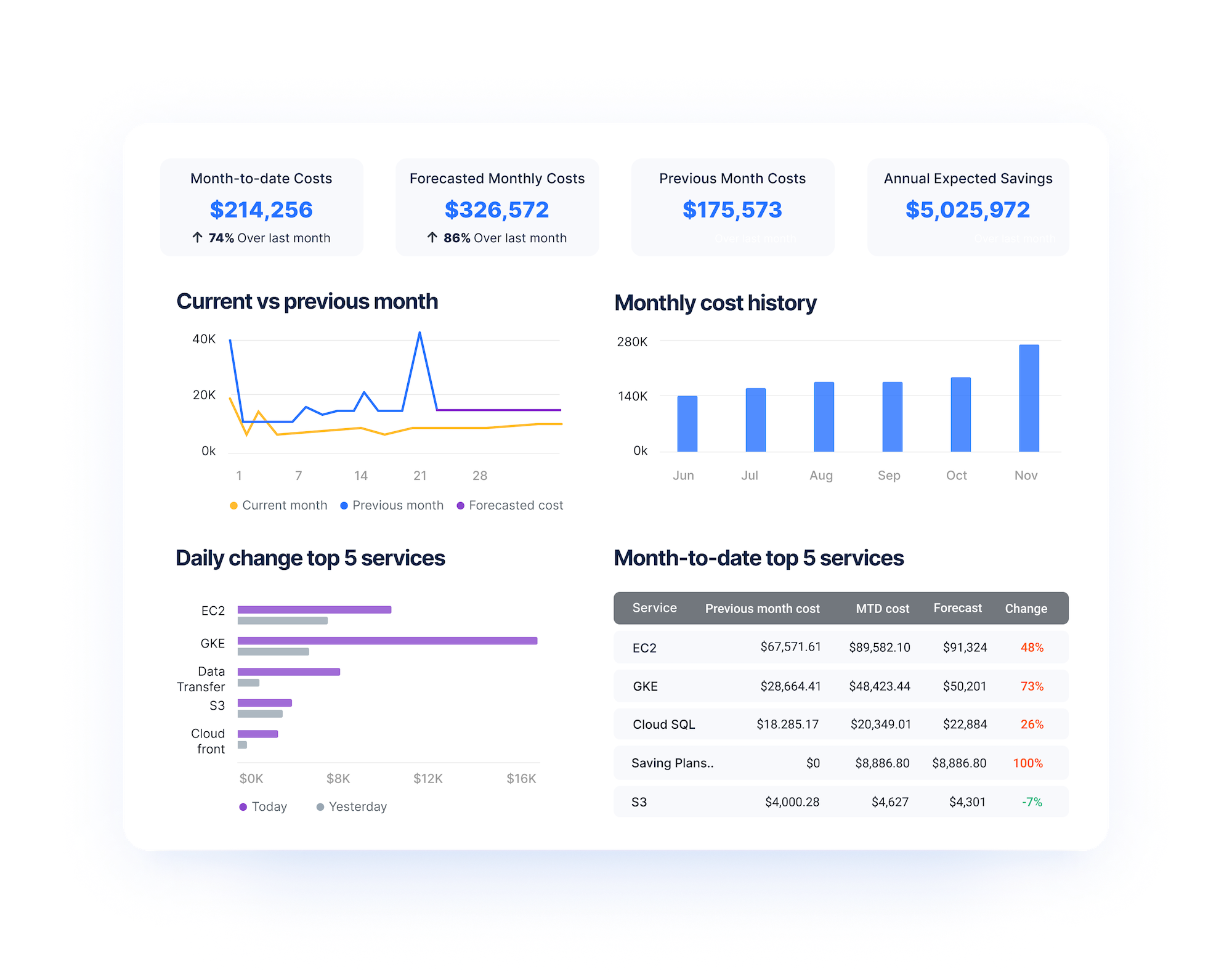Building a Cloud Center of Excellence
As cloud consumption and cloud-based applications become ubiquitous, organizations are realizing the need for cooperation across business units to optimize the value of cloud computing. Many are establishing a cloud center of excellence (CCoE) to govern cloud transformation and optimization best practices.
A CCoE is an important next step for companies currently using ad hoc methods for cloud adoption. While there is a low barrier to entry when it comes to procuring cloud environments, cloud computing introduces complexities that can quickly become liabilities without a governing task force.
With a CCoE in place, businesses can make decisions based on data, have a comprehensive organization-wide framework for their cloud operations, and optimize their cloud portfolio.
What is a CCoE?
A CCoE is an organizational team assembled with the intent to implement the best practices, governance, architecture, and training necessary to ensure efficient cloud adoption across the enterprise.
A CCoE provides IT with a roadmap to execute the organization’s cloud strategy and governs cloud adoption across the enterprise with the help of cloud management tools and policies. It is meant to establish repeatable cloud standards and processes for all organizational stakeholders to follow in a cloud-first approach. Moreover, it is a central part of cloud cost management which helps determine ROI for cloud operations.
What are the key benefits of a CCoE?
Without a CCoE in place, various departments in an organization may fail to collaborate and share information about cloud projects. Each department may have its own cloud initiative and establish separate practices, resources, and accounts. As a result, there may be duplicated efforts, project delays, wasted resources, and unnecessary costs incurred by the business if different departments implement their cloud projects in silos.
With a properly implemented CCoE, businesses will enjoy the following key benefits when it comes to cloud adoption:
Uniformity:
An organization will be able to establish guidelines, best practices, governance, and security measures for each individual business unit to follow. When different departments initiate cloud projects, they will no longer be implementing them in silos as they’ll have uniform guidelines and best practices to follow.
Acceleration:
Businesses can jumpstart cloud projects with more speed and achieve greater success with the help of a CCoE in comparison to independent departmental cloud initiatives. Both the leadership and IT teams will know the steps to follow to achieve business goals with the help of the cloud.
Cost Savings:
Some of a CCoE’s key functions are to facilitate communication and manage the cloud environment. This oversight is essential since every cloud activity has an associated cost. For example, it’s common for developers to put workloads in the cloud that few others are aware of, with no responsibility for managing spending.
Efficiency:
In conjunction with a cloud cost management solution, usage can be optimized to minimize cloud costs across the enterprise. With the help of common guidelines and best practices, cloud deployment becomes easier to implement, improve, and also troubleshoot. What’s more, customers and end-users will be supported by best practices and innovation.
How should you go about building a CCoE team?
Form a small core team for the CCoE implementation
The first thing to keep in mind is that you should have a small team consisting of the right people responsible for implementing the CCoE. If the team is too large, decision-making may become extremely difficult. In an ideal scenario, the team should have management representatives, core business functions, IT, and end-users. If you feel that there is a knowledge gap in your team, consider getting a partner or expert help in the form of an experienced new hire or an external consultant.
Common job titles for CCoE team members
In an ideal scenario, someone with experience in the role of a lead cloud architect can be appointed as the leader of the CCoE. However, team members with a broad skill set are especially desirable. Leaders from operations, finance, IT roles, and also C-suite members can be part of the CCoE team. Some common job titles for CCoE team members may include:
– Lead cloud architect
– Systems architect
– IT manager
– Systems administrator
– Database administrator
– Application developer
– DevOps manager
– Network engineer
– Security architect
– Cloud engineer
Essential qualities to look for in your CCoE team members
Implementing a successful CCoE means ensuring you can form a team with not only the appropriate skills but also the following qualities:
The ability to understand “Cloud as a Product”
Before an actual migration, the cloud may be unfamiliar to some people within your organization. One of the core responsibilities of a CCoE is to address any questions or concerns that employees might have regarding cloud use. To ensure this, CCoE team members should be able to understand “Cloud as a Product” and be able to educate and train employees so that they become knowledgeable about how moving to the cloud can benefit the organization.
According to Gartner, “A CCoE should raise the level of cloud knowledge in the organization and capture and disseminate best practices through a knowledge base, source code repository, training events, outreach, and more.”
Be adaptable and open-minded about new processes and technology
Change is inevitable with the adoption of new technology and/or the implementation of new processes. All CCoE team members must be adaptable and have an open mind. A CCoE’s operating principles and structures should also reflect such a mindset when adding services or selecting vendors.
Possess excellent collaboration skills
Implementation of a CCoE has to be a collaborative effort. The CCoE team is responsible for policy creation and providing resources across the organization when it comes to cloud adoption. All team members must necessarily possess excellent collaboration skills. They should be willing to serve as a valuable resource at all stages of the cloud transformation.
How can you ensure success with your CCoE?
Here are five factors to keep in mind for establishing a successful CCoE:
Knowledge
A CCoE needs to have a detailed understanding of the target cloud, the cloud’s services and resources, performance under different workloads, reporting, monitoring, auditing mechanisms, and last but not least, cost optimization. This in-depth knowledge is imperative to lead the business through successful cloud adoption across the organization.
Collaboration
A CCoE team should have a cross-section of perspectives and complementary skills. Team members should include staff with expertise in infrastructure, operations, security, and applications. The team should also have business leaders who can help align goals and policies for cloud adoption that are in sync with overall business plans.
It is vital to form a team that collaborates well among themselves and the rest of the organization. The reason for this is that the team should be able to share specialized perspectives to drive cloud adoption.
Support
A CCoE team will succeed only if it receives organizational-wide support at all levels. Business leaders should lead the way in helping the team establish authority and credibility to establish and disseminate cloud policy, governance, and practice. In addition to business leaders, support is also needed from employees, department heads, and users.
Focus
A CCoE team should have laser focus in terms of scope and goals. It is a good idea for teams to start off with a few straightforward cloud projects to bring about quick wins and cost-saving that can be easily quantified. With experience, the CCoE team can take up more complex projects.
Adaptability
A successful CCoE team is always dynamic. The team should constantly be exploring emerging cloud resources and services and adjusting best practices to meet the needs of the business. Team composition should also necessarily be adaptable, with the CCoE leader being able to change or add members as and when needed.
Optimize your CCoE with Anodot’s cloud cost management solution
One of the key objectives of a CCoE is to be able to monitor organizational spend, establish governance policies, and ensure efficiency when moving to the cloud. Keeping this in mind, being able to gain visibility into your infrastructure usage, cost, and performance is a vital step when it comes to enabling your CCoE team.
You can gain this visibility with Anodot’s Cloud Costs Management Solution. Anodot is built with the objective of offering cloud teams a contextual understanding of cloud costs, and the impact of business decisions on cloud spend across the organization.
Anodot seamlessly combines all of your cloud spend into a single platform, enabling a CCoE team to monitor and optimize cloud cost and resource utilization across AWS, GCP, and Azure.
Anodot automatically learns each service usage pattern and alerts relevant teams to irregular cloud spend and usage anomalies, providing the full context of what is happening for the fastest time to resolution. The platform leverages proprietary ML-based algorithms to offer deep root-cause analysis and recommended remediation. With continuous monitoring and deep visibility, you gain the power to align FinOps, DevOps, and Finance teams and cut your cloud bill.





